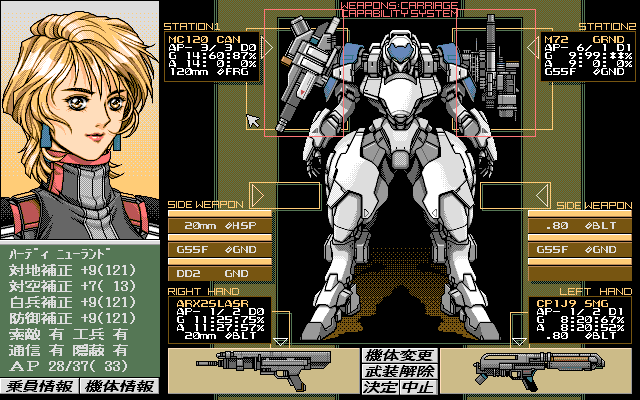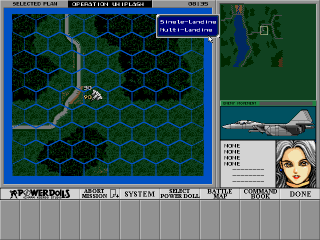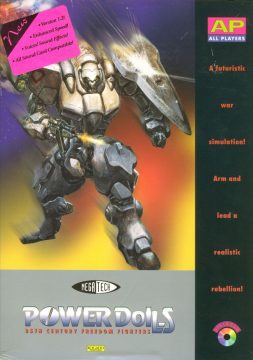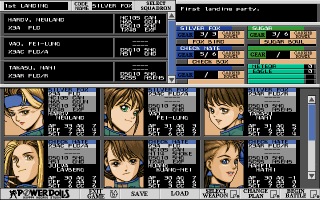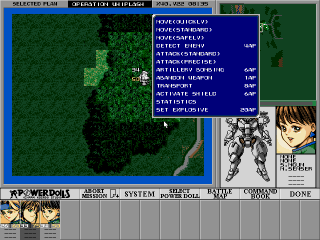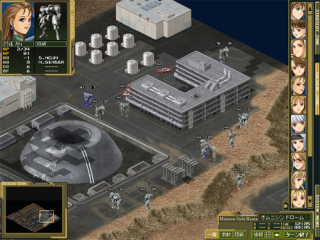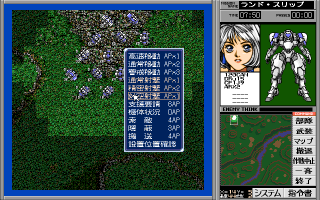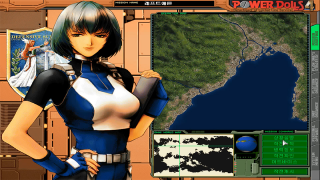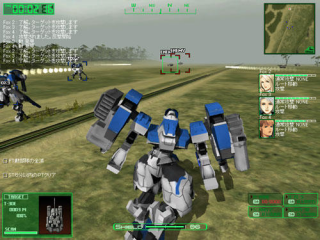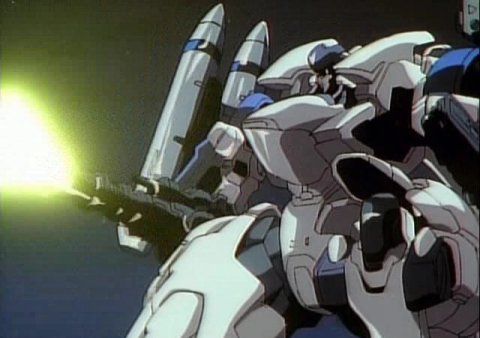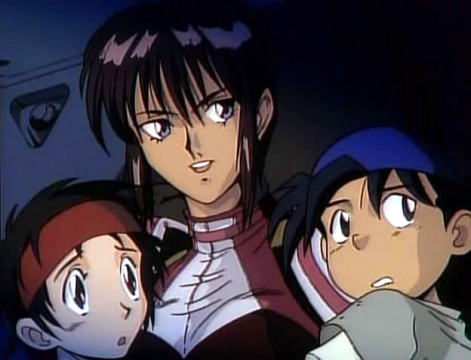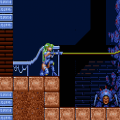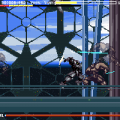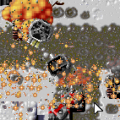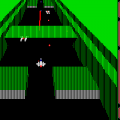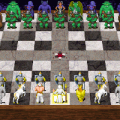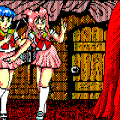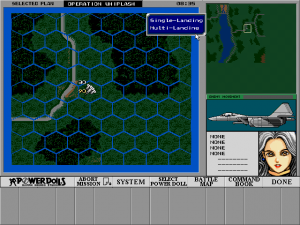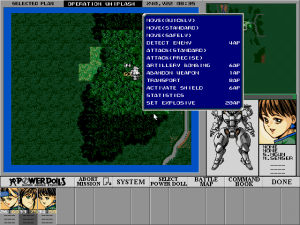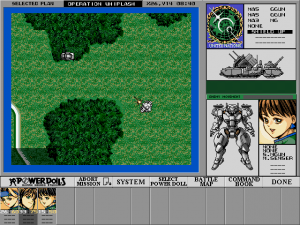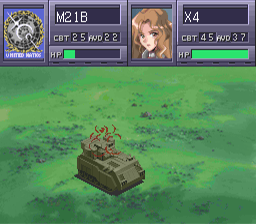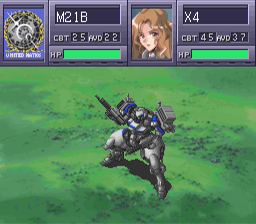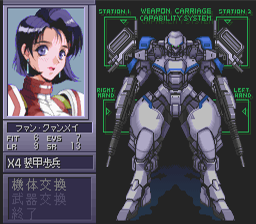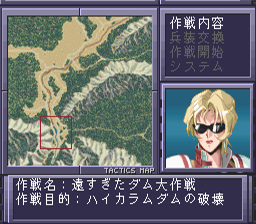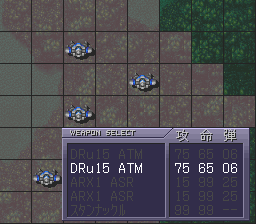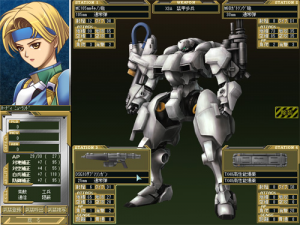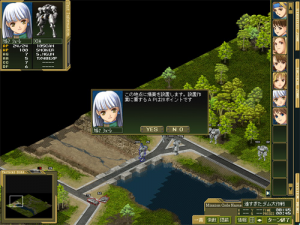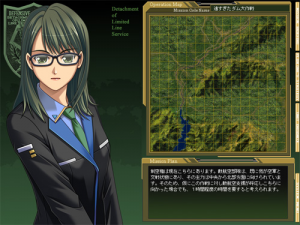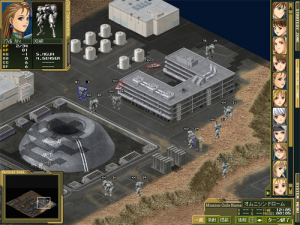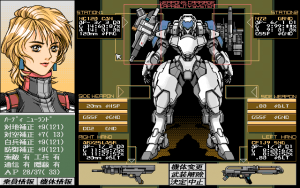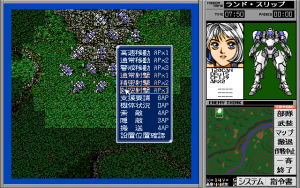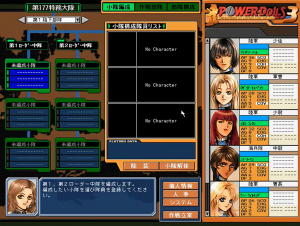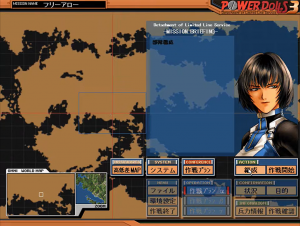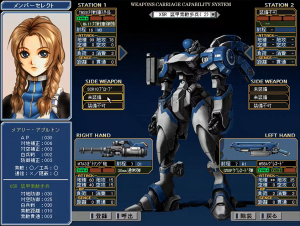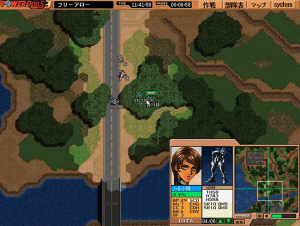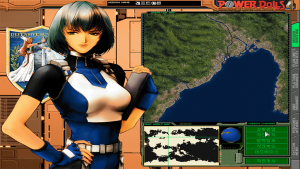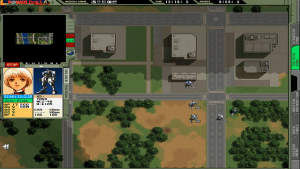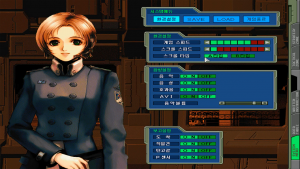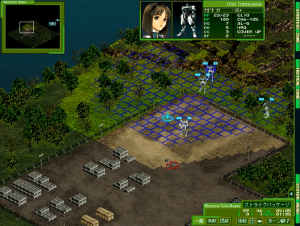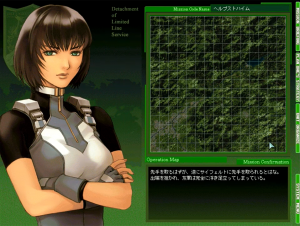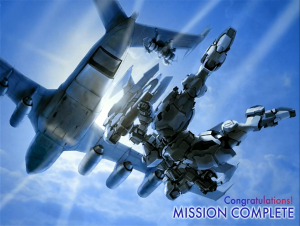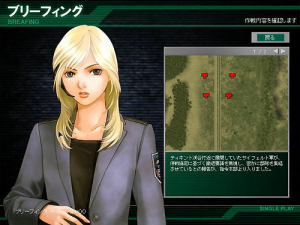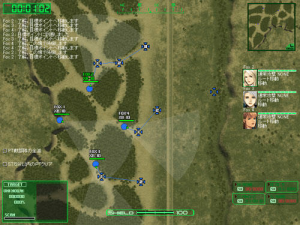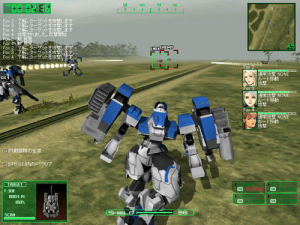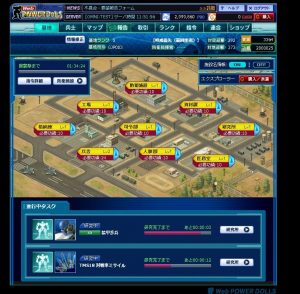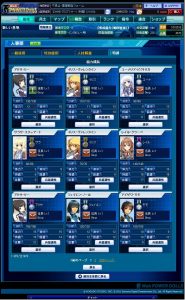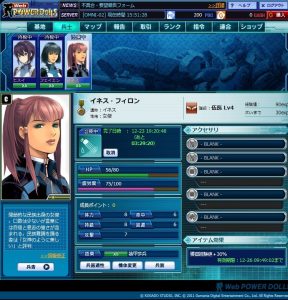Little is known in the West about the POWER DoLLS series, apart from it being an obscure turn-based tactical strategy game developed and published in Japan mainly by Kogado Software Products, currently the internal development branch of Kogado Studio (whose original foundation traces back to 1916 when it was named Design and Prints Tani Kogado and then re-established as Kogado Studio in 1960, mainly focusing on graphic design). The company, currently led by the President and CEO Ippei Tani, started researching about video games around 1982 after having witnessed major hits like Nintendo Game & Watch or similar works done by Tomy or Bandai. In the following year they published their first video game ever, the PC-88 game Slot Crazy (thus becoming one of the few companies at that time who were PC developers, alongside Nihon Falcom and Koei), and then continued until today in producing software, mainly visual novels like Symphonic Rain or Tristia of the Deep-Blue Sea but also RPGs like the Sequence Palladium series or strategy games like our POWER DoLLS.
Now, the first game in the series, named in the same way and published in 1994, is set in the year 2535, when the fictional planet Omni declared independence from the real planet Earth. The “natural” reaction was obviously a series of violent repressions that really put a strain on the resistance forces. But things started to change five years later when Omni scientists managed to convert into battle mechas some devices called Power Loaders, originally intended for civilian use only. The 177th Squadron was officially formed. And the most interesting fact about these mechanized battlesuits? They are manned by an all-female team of beautiful pilots named DoLLS (which stands for Detachment of Limited Line Service).
Games:
Now, why was it mentioned that this game is almost unknown in the West? After all, POWER DoLLS is not part of that group of titles that never left Japan (and that maybe haven’t even received a fan translation): it was actually released in English-speaking countries in 1995 by the little-known American company MegaTech Software (though physical copies of this version are, as it always happens, nearly impossible to find). However, sales of POWER DoLLS outside Japan were apparently not enough to convince Kogado into translating the next games in the series. It has been theorized that the poor reception was mainly due to excessive difficulty spikes, starting from the very first mission: in fact, the game just tosses you into the battle with no clear tutorial and not even a clue on which of the many interface buttons should be pressed, during the initial customization phase of your commando force. And when enemy reinforcements will start pouring in the average player is likely to ragequit due to the fact that the mess found in the initial phase is likely to be tripled in the combat one.
Now, you will probably spend at least 15 minutes in the main troop selection menu trying to figure out what on earth are you supposed to do: there is no tutorial whatsoever and you just have to randomly click on the different sections like “select weapon” or “change plan” in order to understand something, while your eyes are just overrun by too much text and statistics on screen (it is true that these issues can be at least partially solved with the aid of the manual, if you are able to find one, which carefully explains many technical aspects of the game and some lore elements, yet it will arguably not completely remove the confusion and the difficulty spikes will still be there). You can select few weapons for your Doll like the ARX1 which is the standard assault rifle with some chances of critical shot or the more reliable grenade launcher M51, even if a little inaccurate, and you can also select artillery vehicles and aircraft carriers, about which you will gain progressive knowledge through the game, also thanks to trial and error. After this initial set-up, the first mission starts: codename “Operation Whiplash”.
The view is top-down and you will need to move your transport aircraft in the most strategic position across the main map, subdivided by hexes. In case of incoming fire, you will be pretty well shielded and if you upgraded your carrier with additional equipment during the previous phase you will be even able to respond to enemy fire; it is now time to make your 1st wave land, with your brave Dolls being deployed few hexes away from one another (if you chose the multi-landing option), ready to blow up the dam in order to prevent the United Nations troops to further advance (this is your main task for this first mission).
It may be useful trying to overwhelm single enemies by encircling them with 3-4 of your Dolls and then unloading tons of ammo on them (maybe also through the Attack Precise mode) so that the slightly inaccurateARX1 would still able to do some heavy damage but be careful, as your expensive Power Loaders may be still easily destroyed by less expensive enemy tanks or APCs; in the meantime, it’s important to remember using the artillery to weaken enemy units that are further away (or even completely destroy them, even if they tend to move often and it also takes one extra turn for shells to hit the ground) so that your Dolls will encounter less resistance as soon as they get there. And saving frequently is highly suggested!
As previously stated, the whole first impact may seem overwhelming. And it is. But if players manage to resist quitting and if they manage the field situation properly, satisfaction at the end of the mission will be guaranteed (and not only thanks to the bonus scantily clad pilot BMP image you get at the end of any mission).Good luck for the last mission, which has become (together with the first one) quite a meme for the 4-5 POWER DoLLS fans around the world, due to its impossible difficulty.
A remake of the first installment came out two years later as POWER DoLLS FX for the not-so-lucky PC-FX, developed by the same company and published by NEC itself: it is basically a refurbished version of the previous game with few cool additions, like the possibility of somehow train before actual missions in what is called a Scenario Mode (nothing exceptional, just a basic terrain with few trees and enemies and some occasional radio advices by your superior) and also a more appealing attack phase since the view will change to isometric, giving a more dynamic 3D feel and with custom animations of your Doll using the weapon you chose to use in that moment and of the enemy being hit. Also, conversation phases tend in this case to breathe more life into the characters, probably thanks to Kogado’s heritage and experience in developing visual novels. These are bonus points, which arguably help the PC-FX version to stand out a little more than the versions of the first POWER DoLLS since, for the rest, the graphics can be considered a little less detailed in this case and the battle grid is way too similar to the one of Super Robot Wars.
But good things come in threes and Kogado couldn’t consider itself done with the first episode without another remake, this time for Windows, probably developed in order to both test the new PD5 engine and also save the identity of its somehow damaged brand after the flop of POWER DoLLS 6, which will be discussed later. POWER DoLLS 1 (2009) managed to bring not only a renewed graphical interface and an isometric 3D-like view during combat missions but it also introduced small interesting details like a more decent initial equipment (compared to the 1994 version) or the fact that you will sometimes stumble upon high altitude obstacles that can be used for strategic purposes; but, apart from other minor differences concerning abilities stats, the game still remains very resembling to the original, consuming AP (action points) to move, shoot and basically do anything. The physical and digital versions included two bonus elements: a remastered soundtrack named KOGADO Collection Power Doll and the original PC-98 version of the game, brought back to life thanks to the emulation project EGG.
The sequel of the first title was POWER DoLLS 2 (1994) and maintained more or less the same setup of its predecessor except for a little more diversity regarding the terrain, few interface tweaks and additional outfits for your mechas.
The title subsequently received two expansions named POWER DoLLS 2 Dash and Advanced POWER DoLLS 2 which didn’t really bring any major change except few graphical polishing, some additional units and weapons and new missions like a new campaign which involves a series of infiltrations of important Earth-controlled strategic locations. A compilation of these two games was included in the POWER DoLLS 2 Plus Dash version and then a final all-encompassing special release named POWER DoLLS 2 Complete Box came out in 2008 (which included the previous titles, the two OVAs, an artbook, the Power Dolls 2 Sound Selection soundtrack with new bonus songs by Hiroto Saitoh and a Mania Kit with additional digital content). The so-called “1st Generation” of the Power Dolls games (which depicts Omni units battling against Earth forces and the rebel organization Jias) was officially over.
Instead, the “2nd Generation” saw Windows-only games (where the background is the war against the Republic of Syfeld) and opened for a drastic change to the gameplay: real-time strategy with the possibility to pause the game. POWER DoLLS 3 claimed to be a title more diverse and deeper than its predecessors: in fact, you can organize your platoon in particular ways that will unlock new abilities of some individual members, according to the combination. Also, members can now be promoted on the battlefield, so that players will be able to make their favorite character as the platoon leader, with the captain being the highest-ranking member. Additional elements featured a new zoomed-out mini tactical screen in order to help making more sound tactical decisions and for the first time in the series height differences are introduced (later readapted in the last remake of the first title).
POWER DoLLS 4 kind of continues this trend: players begin the game with a setup phase where they learn the status, purpose, terrain and time for each mission and then start forming the platoon, customizing both the Dolls and the equipment. As the previous game, members can be promoted in the same way: the only novelties are characterized by the presence of three new mechas (XB-10, XD-10, XE-10) and by the possibility of changing formation during the mission itself, meaning that the player will be able to adapt better and quickly to unexpected situations encountered in the battlefield. Elements start to become quite scarce as we progress in the analysis of the series, either because (strangely enough) Japanese sources and wikis themselves lack substantial information but also because of the great similarity between the games themselves.
What happened with POWER DoLLS 5 is that Kogado, probably due to the poor reception of the previous two titles, decided to return to the turn-based mechanic, also removing the pause. Moreover, the traditional top-down view switched to a new isometric camera and the hexes were replaced by square tiles, arguably appreciated by JRPGs aficionados who enjoyed Tactics Ogre, characteristics also found in the expanded version POWER DoLLS 5X published in 2002, which featured a new sub-campaign but remained nearly identical to the original for all the other aspects of the game. Both games were included into a final special release, POWER DoLLS 5 plus X, which added a new one-shot mission and the possibility to play multiplayer LAN up to 16 people.
Remember the tragedy mentioned in regards to POWER DoLLS 6? What happened was that in 2004 Kira-san’s team decided to completely revolutionize the core feature of the game, making it nothing less than a third-person shooter. Apparently, the reaction in Japan was so bad that the game soon appeared in the Japanese underground blacklist known as Black History which is a reference, as explained by Davzz, “to Turn-A Gundam, about tragic events in history that were sealed away and forgotten for being so horrifying they lower your faith in humanity”. Just imagine. Now, it would be an exaggeration to consider this game (set after the turmoil with the Republic of Syfeld) a complete failure since it is a decent strategic action game with some vibes that remind the latest games in the Front Mission series or BattleTech and the gameplay is fairly enjoyable but it is necessary to remind that the disappointment is kind of understandable, since the switch to such a drastic gameplay was not introduced gradually and just came as a sudden slap in the face to the traditional and steady Japanese fanbase.
Web POWER DoLLS, the swan song of the series, was developed by a Taiwanese studio named Gamania Digital Entertainment with the supervision of Kogado Studio: a social browser game criticized for the poor quality of character design and 3D animations, too easy combat system and defined by many Japanese user as “interesting at the beginning but quickly boring”. The servers, officially opened in December 2011 with an open-beta were closed down after only three years of service. This title officially sanctioned the end of the series, though not so subtle homages would be sometimes made in the future, like in Xenoblade’s mecha designs, since in the Japanese version they are known as “DOLLS” (“Skell” being its localized name for English regions).
Anime/Manga/Movies/Other Media:
While it is true that the FX title was far from being considered the killer application for that unsuccessful NEC console it still produced an interesting outcome in terms of the OVA adaptation Power Dolls: Omni War 2540 which is basically the anime version of the previously described “Operation Whiplash”. However, don’t expect a fast-paced mecha guerrilla animated story resembling the video game, as the first episode (“Omni History 2540”)tend to focus more on the everyday life and sometimes introspection (though nothing Evangelion-like) of one of the Dolls, Yao, still without neglecting some action scenes.
The second episode, “Project Alpha”, is based instead on the series’ radio drama named Stereo Drama Power Doll (consisting of two productions under the VAP Inc. label, Wedding March and Escapade), which is in turn loosely based on POWER DoLLS 2. Despite this, the plot is fairly original and revolves around a prototype that has gone out of control and the hidden lore behind it (even if it may still remind of some episodes of GITS: S.A.C.).
Conclusion:
Despite everything, the series is recommended, especially if one really loves technical-military strategy games but doesn’t disdain seeing sometimes the cute face of beautiful Omni pilots to cheer up your day. Yes, it is very unlikely that the Usagi-San Team, Kogado’s internal branch responsible for the series, will make POWER DoLLS rise again from the ashes in the nearest future, especially after witnessing the low interest in the West starting from the very first game and the series ultimately declining even in Japan, mostly due to the fall of the Japanese PC Gaming scene caused by the success of consumer consoles; however, the fact that the interest for this strategic turn-based genre actually came back in recent years thanks to XCOM (with whom the Dolls share few similarities like reaction fire and the possibility of tossing a smoke grenade to shield your allied units, breaking the line of sight of enemy units) could justify Kogado in bringing the series to Steam with an English translation, like already done by many JRPG developers and by Kogado itself for its obscure adventures like Palais de Reine, Nurse Love, Yumeutsutsu and Symphonic Rain.
Links:
Mobygames– Game credits, release dates and box cover art for Power Dolls, Power Dolls 2, Power Dolls 2 Dash, Power Dolls FX, Advanced Power Dolls 2 and Power Dolls 3: https://www.mobygames.com/game-group/power-dolls-series/offset,0/so,1a/
A Look at POWER DoLLS: X-Com but Mecha-Precious and rare article by Davzz from Rough Edge: https://ontlogy.wordpress.com/2020/09/05/a-look-at-power-dolls-x-com-but-mecha/
Detachment of Limited Line Service– Kogado Studio’s website page dedicated to the series (Japanese): https://www.kogado.com/sw/contents/usagi/pd_map.htm
WebPOWER DoLLS developer and staff interviews– Details about the browser game Web Power Dolls (Japanese): https://game.watch.impress.co.jp/docs/interview/500040.htmlhttps://game.watch.impress.co.jp/docs/interview/495411.html
Playing with DoLLS – Useful analysis on the FX remake of the first game by Kimimi from Kimimi the Game-Eating She-Monster: https://kimimithegameeatingshemonster.com/2021/07/16/playing-with-dolls/
Power Dolls OVA – aniDB: https://anidb.net/perl-bin/animedb.pl?show=anime&aid=1237
